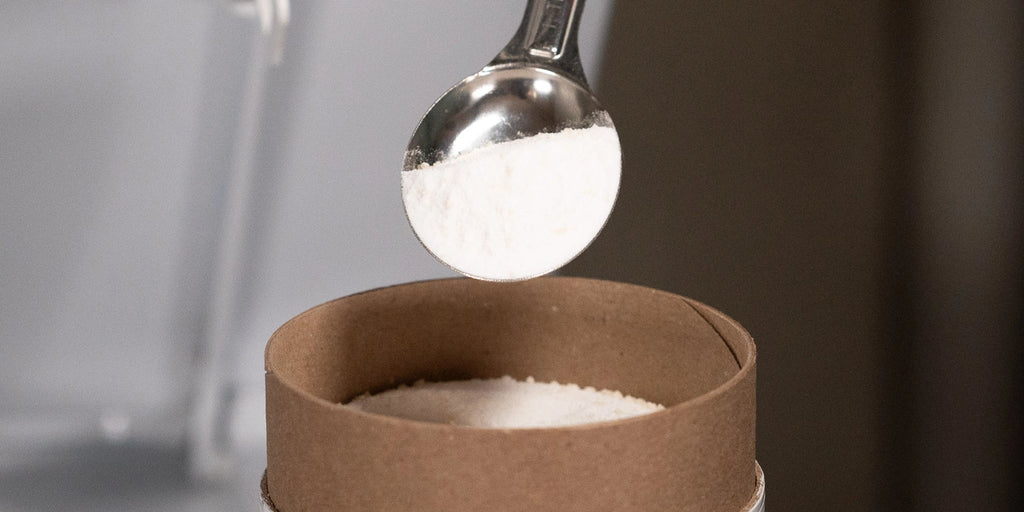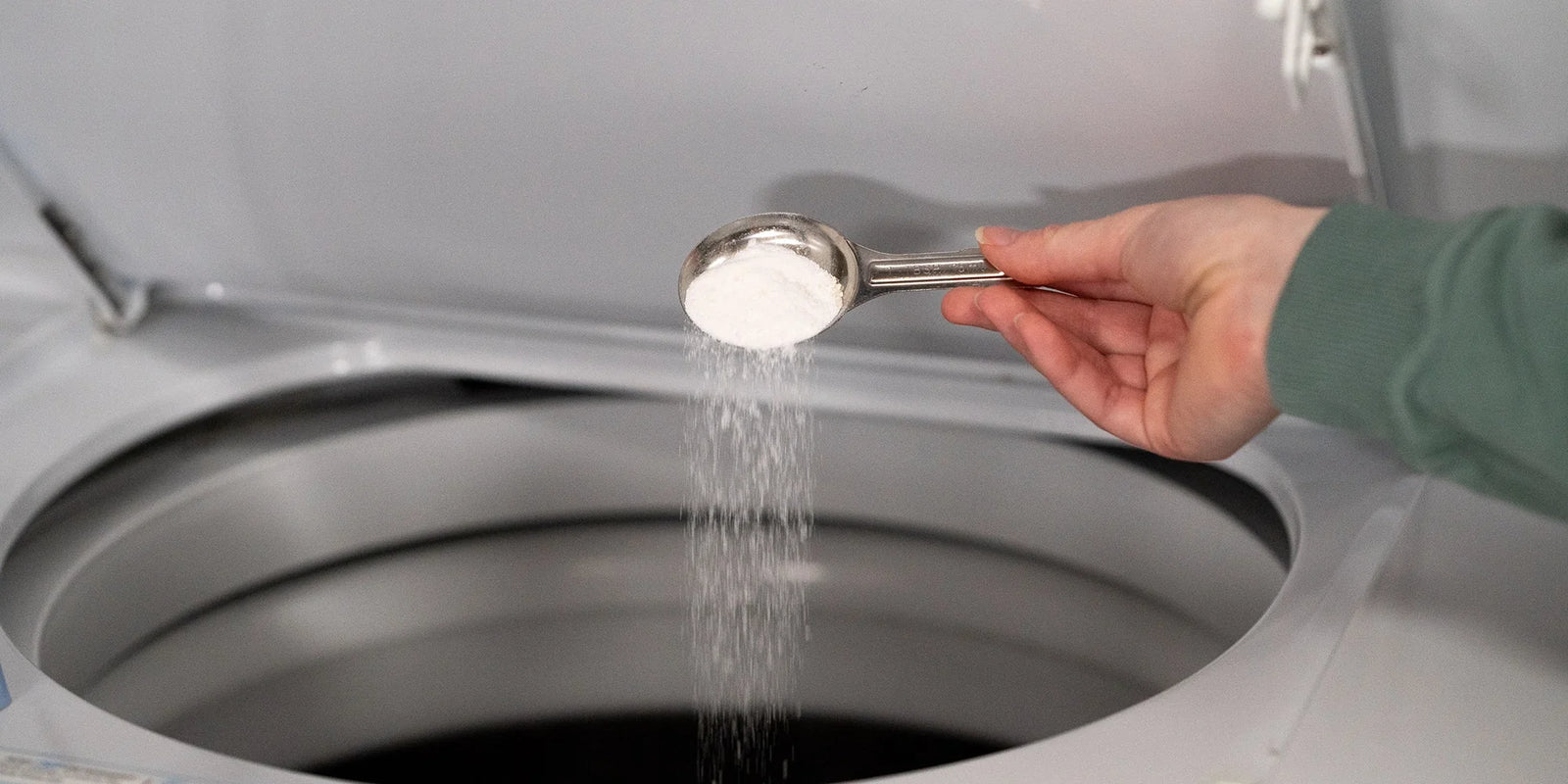When it comes to laundry detergent, we believe that powder is better than liquid for many reasons. To ease the transition from liquid to powder, we’ve put together a guide with every how-to and FAQ you need to use our Laundry Powder with confidence!
How to use Laundry Powder
Laundry Powder is easy to use, but it must be dissolved during the wash cycle to effectively clean your clothes. For best results, follow these steps:
- Use the right amount of powder for your machine and load
- Place powder directly in the washing machine drum before adding clothes
- Use the right temperature setting for your machine and season
We’ll walk through each of these steps in more detail.
How much Laundry Powder to use per load
How much Laundry Powder you should use depends on your washing machine and the size and soil level of the load you’re washing. Start with 1/2 tablespoon if you have a high-efficiency (HE) washer or 1 tablespoon if you have a standard (non-HE) machine. This is based on a typical washing machine size of approximately 3.1–4 cubic feet and a load size of about 12–16 pounds.
The stainless steel scoop that comes with our Laundry Powder canister measures 1 tablespoon, meaning that you may only use about half a scoop per load.

Most newer machines are high-efficiency, meaning they are designed to use less water and energy. If you’re not sure what kind of washer you have, first check your machine. If it has an “HE” logo on it, then it’s a high-efficiency machine. Otherwise, check the user manual that came with your machine or search for it online. You can usually find the model number under the lid on top-loader machines or behind the door on front-loader machines.

You can adjust the amount of powder used based on the size of the load. For very small loads, use a bit less. For very large loads, add a bit more. You don’t need to be too precise, so you can eyeball the amount you use. The goal is to get enough powder to effectively clean your clothes while completely dissolving in the wash (more on that later!).
The same goes for the soil level of the load. If your clothes are particularly dirty, such as from gardening, exercising, or cleaning the house, you can add a bit more powder for more cleaning power. If your clothes aren’t too dirty and just need a light clean, you can use less powder.
Where to put Laundry Powder in front-loader washing machines
In front-loading washing machines, simply add the powder directly to the drum before adding clothes. This will ensure that water can easily reach the powder, helping it dissolve. It also prevents powder from getting caught in the folds of your clothes during the wash cycle.
For best results, do not add the powder to the dispenser drawer. Many washing machines are designed for liquid detergent, and the drawer may not get flushed with enough water to dissolve and wash out the powder. Undissolved powder doesn’t clean your clothes and can build up in your machine over time, causing unwanted odors and dinginess.
Every machine is different and some may have an effective water flush in the drawer. If your powder doesn’t seem to be working when added directly to the drum, it’s worth trying the drawer instead. Oftentimes, the drawers have a small door that you will have to move from “liquid” to “powder” when using powdered products.

Where to put Laundry Powder in top-loader washing machines
In top-loading machines, lift the lid and add the powder directly to the drum before adding clothes. Just like with front-loading machines, the bottom of the drum is the best place for water to reach the powder and dissolve it near the beginning of the wash cycle. Once again, we recommend skipping the dispenser drawer on top-loaders.
What temperature water to use for laundry
Most laundry detergents and soaps require water that is at least 60 degrees Fahrenheit (15.56 degrees Celsius) to work properly. This is true for powder, liquid, pods, sheets, tablets, and any other form of detergent. Although liquid detergent is already mixed with water in the bottle, warmer water is required to fully incorporate it with the water inside the machine.
So, what setting should you use to reach the right water temperature? In most modern washing machines, the ‘cold’ setting actually uses a mixture of hot and cold water to reach 60 degrees F, the minimum viable temperature. That means that in most cases you can use powder detergent on the cold cycle and get great results while saving energy and money.
However, there are some exceptions:
Cold weather laundry
‘Tap cold’ does not add hot water to adjust the water temperature, unlike the ‘cold’ setting. It simply uses water straight from the pipes in your home, meaning the actual temperature varies depending on the conditions outside. During the cold winter months, this might mean a dip below that ideal 60 degree water temperature.
For best results, we recommend using ‘cold’ instead of ‘tap cold’ if your machine has both options. If you’re doing laundry in really cold weather, you might want to use ‘semi-warm’ or ‘warm’ to ensure that the water gets to the right temperature fast enough.
Sanitizing
Cold water is great for most everyday washes, but sometimes you may want to sanitize a load of laundry. According to the CDC, “you probably do not need to sanitize or disinfect unless someone in your home is sick or someone sick has recently visited” because “cleaning alone removes most harmful viruses or bacteria from surfaces.“ However, if you do need to sanitize clothes or bedding, hotter water can help.
Care instructions
Certain fabrics may require specific water temperatures. While cold water is best for delicate, dark, and colorful fabrics, some items may benefit from warmer water temperatures. For best results, always defer to the care instructions on the product tag.
Thankfully, our Laundry Powder is safe for most fabrics, including lights, darks, colors, synthetics, wool, and silk.
How to open the Laundry Powder container
Our plastic-free Laundry Powder is packaged in a paper canister with steel ends. To open it, follow these steps:
- Cut the adhesive tab that connects the lid to the can
- Loosen the lid slightly
- Remove the lid from the can using a twisting motion
- Wipe the lid and the top of the can to remove any loose powder
Let’s break that down:
Start by gently cutting the adhesive tab that holds the lid in place using a table knife.

Holding the can by the bottom end, you can then loosen the lid slightly by running a table knife along the edge between the lid and the can. Don’t press too hard during this step, as there is nothing to cut other than the adhesive tab and you don’t want to damage the canister.

Firmly grasp the can in one hand and the lid in another. Use a back-and-forth twisting motion to loosen the lid while slowly pulling it upward.

Once you’ve removed the lid, check for any loose powder where the lid connects to the top of the canister. Wiping this area with a dry cloth can help reduce friction caused by powder caught between the can and the lid.

How to store Laundry Powder
Laundry Powder can be stored in the paper-and-steel it comes in or in the container of your choice. It does not expire. However, if exposed to moisture or humidity, the powder can harden and clump up. This does not reduce its effectiveness, but it should be broken up or crumbled back into a powder before use. If you plan to store laundry powder in a humid environment, we recommend using an airtight container, such as a hinged jar with a rubber gasket. For heavy launderers, our zero-waste Laundry Powder bucket is a great bulk option that includes a resealable lid.
Whatever container you choose, you can save money and reduce waste with our Laundry Powder refills. Each refill contains the same amount of powder as the canister, but comes in recyclable all-paper packaging with no stainless steel scoop.

